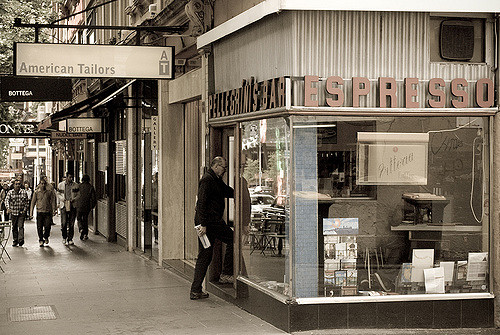Unlock the Magic in Your Story Now
Get the Free 20 questions to Ask Before Launching Your Idea workbook when you sign up for occasional updates.
Get the Free 20 questions to Ask Before Launching Your Idea workbook when you sign up for occasional updates.
Articles filed in: Strategy
More Customers Vs. More For Customers
filed in Marketing, Strategy, Success

Every business begins with the founder’s intention about the outcome he or she wants to achieve. Every aspect of its development stems from that original intent.
As businesses owners, leaders and creators, we can adopt one of two strategies. We can build a business with the intention of getting more customers, or we can want more for our customers.
The outcome we want shapes the kind of business we build.
And the flip side, of course, is that when we want more for our customers, we end up being the kind of company more people want to do business with.
Image by Garry Knight
Why Didn’t It Work?

We’ve been learning by trial and error since we were six months old when we first noticed the effect of our actions on objects. As children we developed skills by learning from our mistakes, paying attention to what didn’t work as well as to what did.
As adults, we are not so keen to see our failures as an opportunity to learn. We might lament about the product launch that didn’t go to plan. The meeting that didn’t pay off. The idea that flopped. But often instead of asking why, we throw the baby out with the bathwater. And in that moment we overlook the opportunity to learn from our failures.
We didn’t learn to build a sandcastle or ride a bike by giving up and moving onto something new right away. We worked out what we needed to adjust, and we adjusted.
The path to success is progressive and iterative. We get there by being brave enough to ask the hard questions along the way.
Necessary Work

Last week I reached out to two different digital companies for technical support via email.
The first company promised to respond within 24 hours. Their eventual reply was a copied and pasted generic email, that likely went out to every person with a similar issue. It was obvious the busy person dealing with my support ticket hadn’t read my original email in full.
The second company got back to me within an hour. Amy at Mailchimp not only replied to my email, but responded to me with empathy and rectified the problem. In a single email, Amy introduced herself and said she would be happy to help. She’d already investigated the issue and fixed the problem. She walked me through this step-by-step in her email response. Then she signed off by saying if I continued to have problems I could reach out again, then wished me well for the weekend. In the reactive world we live in, this kind of thoughtful response feels rare.
It is. It shouldn’t be.
The reason a company exists is to help. If our systems and processes, our products and services or our work and ideas are not helping, then why are they necessary? Necessary work is not only good for customers and businesses—it’s essential for our individual and collective wellbeing. We are hardwired to help. We can’t thrive when we are limited to doing unnecessary work.
If this email landed in your inbox today, it’s because Amy cared to make it happen. Amy is empowered and equipped to do necessary work because the leaders at Mailchimp built their company with this intention. Every one of us has a similar choice to make.
Image by Marc Thiele
What Does Success Look Like?
filed in Strategy

Back in the ’90s, when I was pregnant for the second time, our local health authority announced new measures to cut waiting times at hospital outpatient clinics. This was great news for me and other pregnant women who were often juggling appointments with work or childcare arrangements.
Late on in my pregnancy, I arrived for an appointment and handed in my appointment card. The receptionist noted my attendance and invited me to take a seat in the waiting room, among the dozens of other women flicking through worn out magazines or wrestling tired toddlers. I had barely sat down when a nurse called my name. Unbelievably, the clinic wasn’t just running to time—it was running ahead of time! On every other occasion that I’d attended waiting times had been over an hour, often two. The long wait was accepted as a fact of life. Doctors just run late. And yet, that day I was being seen immediately.
The nurse took me into a side room, weighed me, took my blood pressure, tested my urine and documented the time I’d ‘been seen’ in her paperwork. Then she brought me back into the waiting room where I sat for another two hours before the obstetrician finally called me in.
On paper, it looked like the clinic was doing a great job of keeping to scheduled appointment times. On paper, it looked like patients were in and out of the clinic in no time. On paper the health authority was hitting its targets. But in reality nothing much had changed for the patient.
It’s easy to design the system that looks efficient on paper.
It’s easy to show up to a meeting without being present while you’re there.
It’s easy to reply to an email with a generic reply without ever responding to the problem.
It’s easier to treat the symptoms than it is to get to the heart of the problem.
Getting to the heart of the problem and caring enough to fix is way harder. But ticking boxes or papering over the cracks doesn’t meet our customer’s desire to feel seen and heard. And it doesn’t fulfil our need to do meaningful work either. That’s why the energy we devote to getting better at the hard part is worth it.
How we define and measure success changes how we shape the world.
Every one of us has the power to do that.
Image by Orbis
The Convenience Trap
filed in Marketing, Storytelling, Strategy

The homeless man sitting at the Brunswick Street junction doesn’t look up as people walk past. He doesn’t try to catch the eyes he knows are trying to avoid his. He lets the cardboard sign at his feet do the talking. The headline in red crayon tells us that he’s genuinely homeless. There isn’t enough time for a passer-by to take in the detail of most of the rest of what’s written on the sign in smaller print. But the unusual call to action at the bottom stands out.
‘If you’d like to consider regularly donating $5 a month please let me know.’
The homeless man request knows that he doesn’t just need more donors, he understands that he needs more of the right donors—who keep coming back.
In recent years we’ve seen the rise of businesses that make it easy for us to become returning customers. These businesses have worked out that convenience is sticky. And so we’ve seen the rise of subscription services for everything from razors to flowers and apps that will have a meal or ride to our door in minutes. But convenience alone isn’t what drives thriving, sustainable businesses. Companies that merely offer a convenient solution risk disruption. They must live in fear of the next new thing that’s closer or cheaper, faster or fancier.
If we want to earn loyal donors or customers, we must offer them more than convenience. Loyalty is a byproduct of resonance and convenience. Successful causes and companies don’t only make life easier for their donors or customers—they strike a chord with them too.
Image by Kevin McShane
The Power Of Actionable Feedback
filed in Strategy

How many times do you politely leave a restaurant after a bad experience, vowing never to return, without letting the manager know what you think?
How often have you stopped buying from a brand you once trusted without telling them why?
How valuable would your feedback be, if only these companies were in the habit of asking for it?
It’s hard to ask questions that elicit useful feedback. Fear about the response we might get holds us back because suggestions inevitably make work for us. The trick to making feedback actionable is to ask a specific question of the right people at the right time.
You don’t need everyone’s opinion about everything to improve your product, service or business. But it’s important to ask the people who matter questions about the things you are willing to change.
Image by Garry Knight
Two Ways To Think About Selling
filed in Marketing, Storytelling, Strategy

Are you selling or are you showing up in the best light for the people who need you?
Sales can be a service. And vice versa.
Image by Garry Knight
Lucky By Design
filed in Storytelling, Strategy

The cathedral was packed. More than a thousand people arrived on a warm Tuesday morning to attend cafe owner, Sisto Malaspina’s funeral. Many more stood outside—others watched the service at home on their laptops or giant screens in Melbourne’s Federation Square. We were there, not to mourn Sisto’s death, but to celebrate how he had lived. Sisto was a man who was grateful for the privilege to serve people. He felt fortunate to do work that mattered to him. And how he did that work became a reflection of his life and his legacy. Sisto was lucky, for sure.
After the service, the crowd slowly filed out the front entrance. People began talking as we got closer to the door. Two men behind me spoke about the service. Then one asked the other what he was up to next. “Are you heading back to work?” “Yeah, worse luck,” his friend replied.
During the service, one of Sisto’s customers (and friends) had spoken about why he would be missed. “You loved us, and we loved you,” he said. But then he went on to say something that people don’t often articulate. “There’s been a moment when we all wished we were Sisto.”
It was true. Everyone wants to show up to work with as much gratitude and joy, passion and pride as Sisto had done. Not just the people who were fortunate enough to be served coffee or pasta by him at Pellegrini’s—but you and me too.
It’s easy to think that it was alright for Sisto. He had his own business. He was doing something he loved. He was in charge of his destiny. He was one of the lucky ones. Many of us are not that lucky. But what if we could find a way to feel like Sisto? To be lucky by design and to feel fortunate for the work we do—whatever that work is. What if we looked for the moments in our day to make a difference? And if we can’t find some joy in our work, a way to do it with heart and soul, then maybe it’s time to think about how we could change that too?
Image by Valberg Larusson
Nurture Vs. Growth
filed in Storytelling, Strategy, Success

It’s virtually impossible to think of building a successful business (or life) without having the intention to grow. But sometimes growth for growth’s sake can be a trap. The idea that we have to make a particular metric go up at all costs can lead to unintended compromises. What if instead of thinking about growing our businesses, our expertise or our influence, we thought about how we could nurture them instead?
When we begin to think in terms of nurturing (protecting something while it grows), we are compelled to be more intentional about how we grow. And focusing on how makes all the difference.
Why does your business need to grow?
How does it need to grow?
What does sustainable growth look like for you?
What are you unwilling to compromise on to achieve growth?
What else should you consider before making your next move?
Every journey involves making two decisions. We happily get to where we’re going by figuring out where we want to end up and how we want to get there. Success comes in more than one flavour.
Image by Garry Knight
 Who loves what you do?
Who loves what you do?